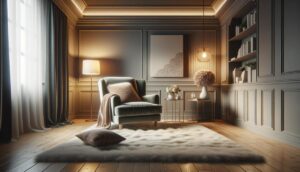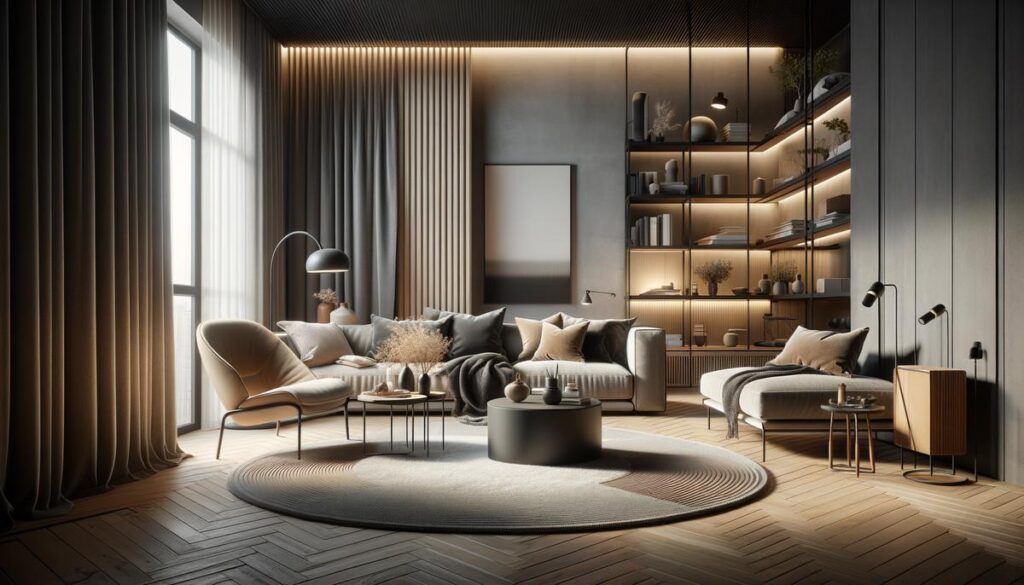How to design your home’s interior to make it comfortable
Making your home a reflection of your personality involves choosing furniture, paint colors, and decor that express your style and create a comfortable space. From selecting a color palette to arranging furniture, this article offers tips for transforming your house into a home that represents who you are.
Identify Your Style and Color Palette
Choosing a Style and Color Palette That Reflects Your Personality
Creating a space that speaks to who you are starts with selecting the right style and color palette.
Discover your style by noticing what you’re drawn to. Are you attracted to sleek lines and modern designs, or does the rustic charm of farmhouse decor appeal to you? Maybe you love an eclectic mix, combining various periods and styles for a unique space. Your style is a reflection of your life, interests, and preferences. Observe patterns in what you already love in your home or saved images.
Picking your color palette is about how it makes you feel. Start with your favorite color as the base, then choose colors that complement or contrast in a way that feels right. If bright and bold colors energize you, embrace that. If soft and serene shades calm you, let those guide your choices.
Balance is important. Too much of one color or very loud colors everywhere can feel overwhelming. Use your chosen colors in various shades and tones throughout your home, whether it’s a bold piece of furniture or small accessories like cushions and art.
Bring in textures to add depth and interest without complicating your color story. Pair smooth with rough, shiny with matte for tactile diversity.
Remember, style evolves. Tweak and adjust as your tastes change or as you find new pieces that appeal to you. Creating a home that reflects who you are is about crafting a space that grows with you.
Start with what you love, add thoughtful planning, and mix in consistency with a touch of spontaneity to create a home as unique as you are.

Optimize Furniture Selection and Arrangement
Selecting and Arranging Furniture:
Picking and placing furniture is critical in personalizing your space. Furniture isn’t just functional; it’s also a major player in your home’s style. Follow these steps to make your living areas comfortable and stylish.
- Measure Your Space
Before buying furniture, measure your space to avoid surprises. Jot down room dimensions and keep them handy when shopping. - Prioritize Big Pieces
Start with big-ticket items like sofas, beds, and dining tables. These cornerstone pieces should be selected carefully, considering the style you’re going for and durability. - Create a Flow
Arrange furniture to create a natural flow from entrance to exit, without obstacles. Avoid setting furniture in walking paths and try floating pieces to define areas without blocking movement. - Mix It Up
Add variety with secondary features such as coffee tables, lamps, and accent chairs. Mix shapes, materials, and colors to add depth and character while maintaining cohesiveness with your overall scheme. - Respect the Room’s Purpose
Consider the room’s function when selecting and placing furniture. Prioritize a desk and comfortable chair for a home office, while a family room might center around a large sofa and entertainment unit. - Test Your Layout
Live with the layout for a few days to fine-tune your arrangement. Tweak as needed for comfort and functionality.
With measuring, consistency, and creativity, your furniture selection and arrangement can transform your house into a stylish home uniquely yours.

Incorporate Comfort through Textures and Lighting
Textures and lighting play a key role in your home’s comfort, impacting the feel and atmosphere.
Textures add depth and invite touch. Mix soft throw pillows on a leather couch, a fluffy rug on a hardwood floor, or shiny surfaces with rustic wood. Balance hard with soft, rough with smooth, including a variety of textures in each room.
Lighting sets the mood. Maximize natural light and layer artificial sources using overhead lighting, floor lamps, and table lamps for a soft, even glow. Dimmer switches adjust intensity based on time of day or desired ambiance.
Consider color temperature. Warm white bulbs create a cozy atmosphere, perfect for living rooms and bedrooms. Cooler white bulbs suit areas requiring focus and energy, like the home office or kitchen.1
Combining textures and lighting is about creating a space that feels good. Experiment to find the right balance for your home.

As we’ve explored various ways to infuse personality into your living spaces, remember that creating a home lies in the details. Whether it’s through chosen colors, arranged furniture, or the play of textures and lighting, each element contributes to making your space uniquely yours. Use these tips as starting points and let your creativity guide you in crafting a home that reflects your style and provides comfort in every corner.
- Wilkins J. The Best Light Bulb Color Temperature for Every Room, According to Lighting Experts. Real Simple. 2023.
Designing your home’s interior to create a comfortable and inviting space involves several aspects, including furniture arrangement, color schemes, lighting, and decor choices. Here are some tips to help you design a comfortable home interior:
Furniture arrangement: Arrange your furniture in a way that promotes good flow and conversation. Consider the function of each room and ensure that there is ample space for movement. Arrange seating areas to encourage social interaction and provide a comfortable balance between openness and coziness.
Color scheme: Choose colors that evoke a sense of calm and relaxation. Neutral colors like soft grays, warm beiges, and soothing pastels can create a serene atmosphere. Use accent colors sparingly to add pops of interest without overwhelming the space.
Lighting: Incorporate a mix of lighting sources to create a warm and inviting ambiance. Utilize natural light as much as possible by keeping windows unobstructed and using sheer curtains or blinds. Supplement with layered lighting, including overhead fixtures, task lighting, and ambient lighting such as table lamps or floor lamps.
Comfortable seating: Invest in comfortable and supportive seating options. Choose sofas, chairs, and mattresses that provide proper support for the body. Consider upholstering furniture in soft, plush fabrics that add to the overall comfort.
Textures and fabrics: Incorporate a variety of textures and fabrics to add depth and tactility to the space. Use cozy materials like plush rugs, soft blankets, and textured cushions. These elements can make your home feel warm and inviting.
Declutter and organize: Keep your space tidy and organized to create a sense of calm and relaxation. Minimize clutter by utilizing storage solutions and keeping surfaces clear. A clutter-free environment contributes to a more comfortable and peaceful atmosphere.
Personal touches and decor: Add personal touches and meaningful decor items that reflect your style and personality. Display artwork, photographs, or mementos that bring you joy. Incorporate elements of nature, such as indoor plants or natural materials, to create a connection with the outdoors.
Consider acoustics: Pay attention to the acoustics of your space to reduce noise and create a peaceful environment. Incorporate soft furnishings, area rugs, and curtains to absorb sound and minimize echoes.
Remember, the key to designing a comfortable home interior is to create a space that reflects your personal preferences and promotes relaxation. Experiment with different elements until you find a balance that suits your needs and makes you feel at ease in your own home.

